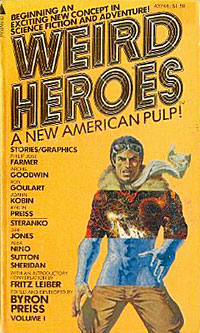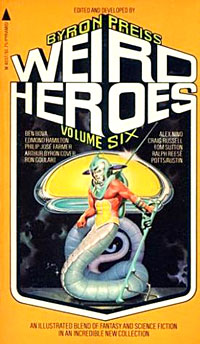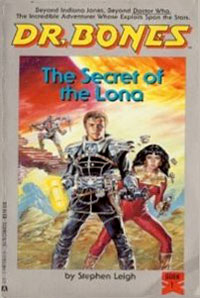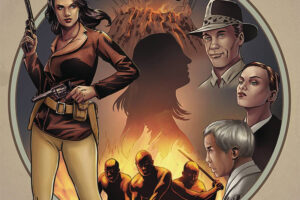 Much has been made of late of the New Pulp movement, made possible in many ways due to the advances in “print on demand” technology that has allowed small presses to finally put out books that can stand up to the mainstream publishers in terms of quality.
Much has been made of late of the New Pulp movement, made possible in many ways due to the advances in “print on demand” technology that has allowed small presses to finally put out books that can stand up to the mainstream publishers in terms of quality.
This has allowed New Pulp publishers like Moonstone, Wild Cat, Altus Press, Wildside, Pro Se, and many others to come out with New Pulp works and well done reprints.
Often overlooked was a previous attempt at starting a New Pulp movement back in the late 1970s led by book packager Byron Preiss: Weird Heroes.
Billed as “A New American Pulp,” this paperback series had New Pulp works from many authors, most well known in the science fiction and comic book communities, combined with interior artwork by top artists like Jim Steranko, who did the first two covers, and Alex Nino, who also did some covers.
Published by Pyramid/Jove/HBJ (who had been reprinting The Shadow novels during 1974-78), Weird Heroes lasted eight volumes from 1975-77. Four of these were anthologies; the others were novels.
Weird Heroes #1
“Greatheart Silver in The Showdown at Shootout,” Philip José Farmer
“Quest of the Gypsy,” Ron Goulart
“Stalker: The Darkstar File,” Archie Goodwin
“Rose in the Sunshine State,” Joann Kobin
“Guts,” Preiss
“Minstrel of Lankhmar,” a discussion with Fritz Leiber
Weird Heroes #2
“Doc Phoenix,” Ted White
“The New York Review of Bird,” Harlan Ellison
“The Camden Kid,” Charlie Swift
“Viva,” Steve Engelhart
“Spv 166, The Underground Express,” Elliot S. Maggin
“The Return of Greatheart Silver, or The Secret Life of Rebecca of Sunnybrook Farm,” Farmer
The first two volumes of WH were anthologies, both with interesting covers by Steranko. We got the first two Greatheart Silver stories by Farmer, about a former zeppelin pilot, now a one-legged detective, being trained by someone who might be The Shadow. We got some New Pulp characters like Goulart’s Gypsy (which was to kick off a series of novels), Goodwin’s Adam Stalker, and others. Doc Phoenix was an interesting character. Not a Doc Savage clone, but a psychologist who helped his patients by actually entering their dreams.
Weird Heroes #3
“Quest of the Gypsy,” Goulart
Weird Heroes #4
“Nightshade: Terror Inc.,” Tappan King and Beth Meacham
Weird Heroes #5
“Doc Phoenix: The Oz Encounter,” Marv Wolfman and White
The next three volumes were all novels. We got the first Gypsy novel from Goulart. The plan was to have a cycle of four novels, with a second cycle later on. Sadly, we only got two Gypsy novels. I never understood why Goulart didn’t continue the series. Nightshade was about a female magician. And we got a full Doc Phoenix novel; this one where his patient is an Oz fan, so the dreams are about Oz. I think this was the first WH volume I obtained, probably because the name caught my eye as a Doc Savage fan.
 Weird Heroes #6
Weird Heroes #6
“Shinbet Investigates,” Goulart
“Orion,” Ben Bova
“50 Years of Heroes: The Edmond Hamilton Papers,” Edmond Hamilton
“The First Command, or Inglories Galore,” Farmer
Galactic Gumshoe: a Franklin Davis Thriller, Arthur Byron Cover
Another anthology. We get the third and last Greatheart Silver story, plus some others.
Weird Heroes #7
“Eye of the Vulture,” Goulart
The second (and last) Gypsy novel, of the planned four.
Weird Heroes #8
“Seward: The Deep Fix,” Michael Moorcock
“Kamus: The Big Spell,” J. Michael Reaves
“Orion 2: Flood Tide,” Bova
“Kamus 2: The Maltese Vulcan,” Reaves
“Robeson: The Grant-Robeson Papers ‘Savage Shadow,’ ” Maxwell Grant (aka Farmer)
And a final anthology. We get two Kamus of Khadizar stories, a second Orion story, and the story that many have heard about, “The Grant-Robeson Papers,” which tells of the “real life” meeting of Maxwell Grant and Kenneth Robeson, who each look like the other’s character (the idea being that they inspired each other). This was meant to be the first of a pair of stories, but the second (to be “written” by Robeson) never appeared, and I have no idea if it was ever written.
Fiction Illustrated
Alongside Weird Heroes, Preiss also oversaw Fiction Illustrated, an early attempt at doing graphic novels (though some were more illustrated novels then full graphic novels). This started out as a digest-size series before going with a larger format. Notable in this series was Steranko’s “Chandler” and “Son of Sherlock Holmes.” “Chandler” has been reprinted a couple of times since, most recently by Vanguard Productions.
After Weird Heroes
After the demise of Weird Heroes, some of these works lived on as reprints. There were also some follow-on works, a few that seemed planned for Weird Heroes before its demise.
At Ace Books in 1979, we got “I, Alien” by Reaves. A second book was promised (“I, Alien in NY”) but it never appeared.
There was also a book of Preiss’ character Guts, who first appeared in WH #1. A second book for this character was also promised but did not appear. Following so closely after the demise of WH, this seems like an attempt to keep things going but never got far.
Also in 1979, we got “Dragonworld” by Preiss and Reaves, with art by Joseph Zucker from Bantam Books. This illustrated fantasy novel was apparently planned as the fifth volume of Fiction Illustrated. This book has been so popular that it’s gone through several printings with different publishers over the years.
Kamus of Kadizhar lived on. First, there was “Darkworld Detective” by Reaves from Bantam Books in 1982. This one reprints the first two Kamus stories from WH #8 plus two new ones. Then “Kamus of Kadizhar: The Black Hole of Carcosa” by John Shirley came out from St Martin’s in 1988.
Tor Books put out a collection of all the Greatheart Silver stories by Farmer in 1982.
It appears that Bova continued his character of Orion in a whole series of works. But I’m not familiar with them, but I believe these two stories here were later incorporated into the first Orion novel.
Hunger Tiger Press, a small press focused on Oz works, put out a hardback reprint of the Doc Phoenix novel Oz Encounter, a few years ago.
 Related to pulp, in the early 1980s, Preiss’ company was involved with the creation of a new serial character called Dr. Bones (the idea came from Steranko, who also did design work). A sort of Doc Savage/Captain Future-type character set in the far future, with the main character being an archaeologist. I am still missing one of these books. Each book was written by a different author, in a scheme known as “sharecropping.”
Related to pulp, in the early 1980s, Preiss’ company was involved with the creation of a new serial character called Dr. Bones (the idea came from Steranko, who also did design work). A sort of Doc Savage/Captain Future-type character set in the far future, with the main character being an archaeologist. I am still missing one of these books. Each book was written by a different author, in a scheme known as “sharecropping.”
The first book was a sort of origin story and a pretty good, but the second one (of course, by a different author) didn’t live up to what the first started.
Then in the 1990s, they did the fourth Tom Swift series, the long-running juvenile SF series.
A few years back, Preiss’ new endeavor, iBooks, reprinted the first volume of Weird Heroes. I thought maybe this would lead to a reprint of the original volumes and maybe a continuation of the series. But shortly thereafter, Preiss was killed in an auto accident and iBooks shut down.
These works are great gems that I think are too often overlooked, especially since they came out from various publishers over a couple of decades. Check them out.




Byron Preiss gets a bad rap for starting the ‘sharecropping’ trend in paperback publishing, but I see the guy as a pioneer who helped usher in a new kind of illustrated prose fiction that appealed to an aging audience raised on comic books. The number of series he launched is vast, including Isaac Asimov’s ROBOT CITY, Arthur C. Clarke’s VENUS PRIME, and on and on. This opened up established authors’ universes to new writers and helped them get exposure to an wider audience, while keeping some classic fictional concepts new and fresh.
The guy’s place in fiction publishing is definitely due for a critical reassessment.